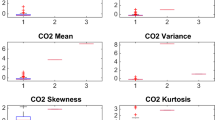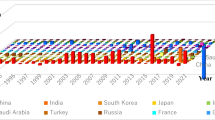Abstract
In an attempt to protect the earth in the era of climate change, effort has been put forth to restrict carbon emission globally. Although Korea is not one of the countries being obliged to reduce carbon emission specified in Kyoto Protocol, it has voluntarily implemented the emission trading scheme. In the midst of current situation ‘low carbon’, ‘green growth’ and paradigm are receiving global attention from the recent issue of climate change. This will provide a direction on understanding the emission trading of Korea in comparison with other developed countries, while determining the future direction of Korea’s emission trading. However, studies and data on domestic and international emission trading are currently lacking. Therefore for the purpose of understanding the nature of emission trading of Korea and corresponding guidelines, this paper analyzed the characteristics of domestic and international emission trading through principal component analysis and cluster analysis. The findings will be useful in identifying emission trading of other countries similar to the position of Korea. The significance of this study was to use the findings to provide reliable reference information for improving emission trading.
Similar content being viewed by others
References
Ahn, H. G. (2009). Comparative study of customer segmentation by using K-means cluster analysis and two-step cluster analysis. Master Dissertation, University of Yonsei, Wonju Korea.
Ahn, J. H. and Kim, B. H. (2011). “A Study on the power expansion planning model considering the emission trading.” The Transactions of the Korean Institute of Electrical Engineers, Vol. 61, No. 7, pp. 957–965.
Gavard, C, Winchester, N., and Paltsev, S. (2016). “Limited trading of emissions permits as a climate cooperation mechanism?.” US–China and EU–China examples, Energy Economics, Vol. 58, pp. 95–104.
Gawel, E., Strunz, S., and Lehmann, P. (2013). “A public choice view on the climate and energy policy mix in the EU ― How do the emission trading scheme and support for renewable energies interact.” Energy Policy, Vol. 64, pp. 175–182.
Hwang, U. K. (2014). A legal study of offset credit system in emission trading scheme, Public Law Research Vol. 15, No. 2.
ICAP (2015). Emissions Trading Worldwide: ICAP(The International Carbon Action Partnership) Status Report.
Kim, Y. W., Ok, K. Y., and Ryu, S. (2009). “Study on Legal issues related with Korean electricity industry introduced by carbon emission credit trading system.” Electrical Engineers Summer Conference, Vol. 7, pp. 14–17.
Korea Government (2015). Intended Nationally Determined Contributions Report.
Lee, J. Y. (2009). Measuring the accuracy of proxy variables with PCA, Master Dissertation, University of Sungkyunkwan, Seoul, Korea.
Lee, H. Y. (2012). “A study on the carbon emissions trading scheme introduced: In terms of regulatory policy instrument mix.” Korea Public Administration Gazette, Vol. 26, No. 2, pp. 89–112.
Lee, J. E., Cho, Y. S., and Lee, S. C. (2015), “A comparative study of EU and Japan ETS for Activation in Korean GHG Emission Trading System.” Journal of Climate Change Research, Vol. 6, No. 1, pp. 11–19.
Min, D. K. (2015). “Supply chain coordination under the cap-and-trade emissions regulation.” Journal of the Korean Institute of Industrial Engineers, Vol. 41, No. 3, pp. 243–252.
Moon, S. H. and Lee, J. G. (1999). “Classification of international container ports by using principal component analysis and cluster analysis.” Journal of Port and Harbor Research. RIPAH Korea Maritime University, Vol. 10, pp. 11–25.
Park. S. I. (2014). Enforcement of the emissions trading scheme implementation status and trends credits allocated, EchoCyan Ltd Leader.
Park, S. Y. (2013). California Emission Trading System 「CGS Report」, Vol. 2, pp. 13–15.
Shin, M. J. and Kim, J. D. (2015). Study on the emissions trading scheme analysis and responsiveness SMEs policy measures.
Shin, S. Y. (2016). Study on Effectiveness and Development Method of Domestic Emission Trading System, Master’s Thesis, Korea University (in Korea), pp. 10–24.
Song, J. J. (2012), SPSS /AMOS statistical methods needed to create paper 21st Century Publishing Company, Professor of Youngnam Foreign language College, pp. 61–277.
Takayoshi, S. and Hajime, S. (2015). Tax versus emissions trading scheme in the long run, Journal of Environmental Economics and Management, Vol. 75, pp. 12–24.
Villoria-Sáez, P., Tam, V. W. Y, del Río Merino, M., Arrebola, C. V., and Xiangyu, W. (2016). “Effectiveness of greenhouse-gas Emission Trading Schemes implementation: A review on legislations.” Journal of Cleaner Production, Vol. 127, pp. 49–58.
Wei, L. and Zhijie, J. (2016). “The impact of emission trading scheme and the ratio of free quota: A dynamic recursive CGE model in China.” Applied Energy, Vol. 174, pp. 1–14.
Yu, H. M. (2014). Current Status and Issues of major carbon emission trading, International Economy International multidisciplinary team, Investigation bureau of Korea Bank.
Author information
Authors and Affiliations
Corresponding author
Rights and permissions
About this article
Cite this article
Park, JS., Kim, BS. Analysis of the positions of domestic and international countries’ emissions trading schemes through principal component and cluster analysis. KSCE J Civ Eng 22, 399–407 (2018). https://doi.org/10.1007/s12205-017-1304-4
Received:
Revised:
Accepted:
Published:
Issue Date:
DOI: https://doi.org/10.1007/s12205-017-1304-4




